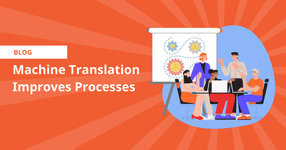Machine translation tools are rapidly evolving, from the first translation engine built by Petr Troyanskii in 1930 to today's application of neural networks, where the artificial intelligence (AI) built into machine translation software processes data similarly to a human brain. Machine translation software is becoming more accurate and reliable, bringing the benefits of machine translation front and center. While machine translation (MT) isn't right for every scenario, it can benefit customers by creating meaningful opportunities to speed up translation, reduce costs, and bring valuable information to new populations.
Increase translation speed with MT
Machine translation can translate documents in a fraction of the time it takes a human, but the quality of raw, untrained output can vary within a single document. Consider using MT services for projects requiring quick turnaround where overall quality can afford some variability. MT can be a cost-effective timesaver for scanning a document for select pieces to translate and gisting (translating for general meaning).
Recent technology enables us to train the AI built into MT software to recognize keywords and topics specific to an industry and adapt translations to voice, tone and style. Machine translation can learn to communicate more clearly within its niche through training.
Consider strategic pairings for cost savings
Adding a human review of machine-translated content is referred to as post-editing. Machine translation post-editing takes the raw output of a machine translation engine and sends it to a human reviewer to improve flow, voice, tone, and style. While post-editing adds cost and time, it is a more cost-effective alternative to using a human for the entire process and can improve quality.
By pairing post-editing and AI training with MT, organizations can build effective overall language workflows that significantly improve turnaround time and reduce costs without sacrificing quality.
Cybersecurity matters
Although they are free and readily available, relying on machine translation services like Google Translate or Microsoft Translator poses significant security risks. Service providers like Google can use any content users enter into their translation engines, including confidential data. Consider using a machine translation service with a high-security portal to keep data safe.
Looking to the future: neural machine translation
Machine translation methods have shifted from statistical to neural network models. This approach, deemed “neural machine translation,” encodes a sentence from one language into a mathematical equation for the decoder of the second language to predict. Although it may not sound easy to most humans, this is a simpler, more cohesive method than phrase-by-phrase translation for an AI. Neural machine translation also learns over time to create more natural translations.
Because neural machine translation requires written content to learn each language, it works well for languages with a lot of written material, such as English, Spanish, and Arabic. Neural MT can struggle to learn languages with hardly any written material, referred to as low-resource languages, resulting in communication gaps. Carl Rubino, program manager at Intelligence Advanced Research Projects Activity (IARPA), recently discussed his thoughts in a BBC article: "Many challenges we face today, such as economic and political instability, the COVID-19 pandemic, and climate change, transcend our planet—and, thus, are multilingual in nature."
The IARPA's MATERIAL program recently began researching a system that uses neural network models to find, translate, and summarize information from low-resource languages. They are not there yet, but they have discovered some breakthroughs, such as more people posting content online in their mother tongues–fresh fodder for training neural machine translation tools. In the future, neural MT may become a critical resource in helping global populations stay safe and healthy.
Making the most of machine translation
Maximize the benefits of machine translation by knowing where to apply MT in the spectrum of your company's communication needs. Most opt for a mix of secure, trained machine translation and post-editing to balance speed, cost, and quality. For a real-life example of machine translation benefits on an enterprise level, check out our team’s recently published Emerson case study.
If you have questions about integrating machine translation into your workflows and content, please get in touch with our data scientists and machine translation experts. We look forward to helping you solve problems and reach your goals.

